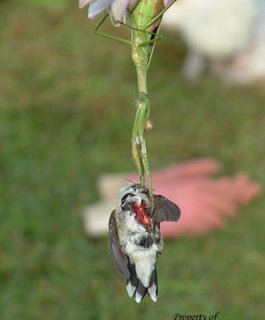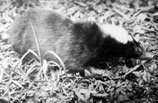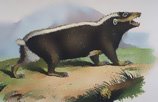
Bonjour tout le monde!
Now, last week I came in for some flack for the brevity of my email...there was me thinking that the delightful picture was enough. But it seems that some of you actually look forward to this drivel! Who am I to disappoint you? This week's animal is Mantis religiosa (European Mantis). There are over 180 species of mantis in the world, but the European one, plain and green, is as good as any. You may have seen them when you've been in warm parts of Europe, stalking shakily about like a camden drunk, trembling as a leaf so as not to frighten their insect (or not, see photo) prey. They are also widespread in North America (again see photo), having been introduced in the late 18th or early 19th century and spreading across the country like tuberculosis through the native Americans. In the picture, the mantis has caught an unusual dinner, stabbing it through the chest with it's left forelimb. As well as their piety, mantises are famed for sexual cannibalism, the male commonly being decapitated during the act. The nuptial gift of his corporeal being might increase the fitness of the female, thus enabling more offspring to survive. Anyway, by way of an apology for last week's lack of verbosity, below is a piece of fiction about mantises that I knocked up this morning. I hope you enjoy. God! This week I've got everything, blood, sex, violence, literature...
The Brothers Mantis
Alexey Fyodorovitch Mantis was the third larva of Fyodor Pavlovitch Mantis, a landowner well known in our district in his own day, and still remembered among us owing to his gloomy and tragic instar, which happened thirteen years ago, and which I shall describe in its proper place. For the present I will only say that this "bug"- for so we used to call him, although he hardly spent a day of his life on his own leaf- was a strange type, yet one pretty frequently to be met with, a type abject and vicious and at the same time senseless. But he was one of those senseless insects who are very well capable of looking after their worldly ichor, and, apparently, after nothing else. Fyodor Pavlovitch, for instance, began with next to nothing; his estate was of the smallest leaves; he ran to dine at other men's crickets, and fastened on them as a tick, yet at his death it appeared that he had a hundred thousand elytra in hard chitin. At the same time, he was all his life one of the most senseless, fantastical mantids in the whole garden. I repeat, it was not stupidity- the majority of these fantastical insects are shrewd and intelligent enough- but just senselessness, and a peculiar national form of it.
He was married twice, and had three larvae, the eldest, Dmitri, by his first wife who tried to eat him after mating so he left her, and two, Ivan and Alexey, by his second who had her mandibles wired shut. Fyodor Pavlovitch's first wife, Adelaida Ivanovna, belonged to a fairly rich and distinguished noble swarm, also mantises in our district, the Miusovs. How it came to pass that a larva, who was also a beauty, and moreover one of those vigorous intelligent girls, so common in this garden, but sometimes also to be found in the neighbour’s, could have mated such a worthless, puny weakling, as we all called him, I won't attempt to explain. I knew a young mantis of the last "romantic" generation who after some years of an enigmatic passion for a cockroach, whom she might quite easily have eaten at any moment, invented insuperable obstacles to their union, and ended by throwing herself one stormy night into a rather deep and rapid puddle from a high twig, almost a branch, and so perished, entirely to satisfy her own carapace, and to be like Shakespeare's Odonata. Indeed, if this twig, a chosen and favourite spot of hers, had been less picturesque, if there had been a prosaic flat bit of moss in its place, most likely the suicide would never have taken place. This is a fact, and probably there have been not a few similar insects in the last two or three gardens. Adelaida Ivanovna Miusov's action was similarly, no doubt, an echo of other people's ideas, and was due to the irritation caused by lack of mental freedom. She wanted, perhaps, to show her feminine independence, to override class distinctions and the despotism of her swarm. And a pliable imagination persuaded her, we must suppose, for a brief moment, that Fyodor Pavlovitch, in spite of his parasitic infection, was one of the bold and ironical spirits of that progressive epoch, though he was, in fact, an ill-natured mantis and nothing more. What gave the marriage piquancy was that it was preceded by an egg sack, and this greatly captivated Adelaida Ivanovna's fancy. Fyodor Pavlovitch's position at the time made him specially eager for any such enterprise, for he was passionately anxious to make a career in one way or another. To attach himself to a good tree and obtain a dowry was an alluring prospect. As for pheremonal attraction it did not exist apparently, either in the bride or in him, in spite of Adelaida Ivanovna's beauty. This was, perhaps, a unique case of the kind in the life of Fyodor Pavlovitch, who was always of a voluptuous temper, and ready to run after any well-turned tarsus on the slightest encouragement. She seems to have been the only larva who made no particular appeal to his senses.
Immediatley after the egg sack Adelaida Ivanovna discerned in a flash that she had no feeling for her husband but hunger. The marriage accordingly showed itself in its true colours with extraordinary rapidity. Although the family accepted the mating pretty quickly and apportioned the scuttle-away bride her dowry, the mantis and mate began to lead a most disorderly life, and there were everlasting scenes between them. It was said that the young larva showed incomparably more generosity and dignity than Fyodor Pavlovitch, who, as is now known, got hold of all her mealy bugs up to twenty five thousand bugs as soon as she received them, so that those insects were lost to her forever. The little village and the rather fine town leaves, which formed part of her nuptial gift he did his utmost for a long time to transfer to his name, by means of some deed of conveyance. He would probably have succeeded, merely from her moral fatigue and desire to get rid of him, and from the contempt and loathing he aroused by his persistent and shameless pumping of air through his spiracles. But, fortunately, Adelaida Ivanovna's family intervened and circumvented his greediness. It is known for a fact that frequent fights took place between the husband and wife, but rumour had it that Fyodor Pavlovitch did not eat his wife but was eaten by her, for she was a hot-tempered, bold, dark-browed, impatient mantis, possessed of remarkable physical strength. Finally, she left the house and ran away from Fyodor Pavlovitch with a destitute entomology student, leaving Mitya, a larva of three years old, in her husband's tarsi. Immediately Fyodor Pavlovitch introduced a regular harem into the house, and abandoned himself to orgies of drunkenness. In the intervals he used to stalk all over the province, complaining tearfully to each and all of Adelaida Ivanovna's having left him, going into details too disgraceful for a mantis to mention in regard to his own married life. What seemed to gratify him and flatter his self-love most was to play the ridiculous part of the cannibalised husband, and to parade his woes with embellishments.
"One would think that you'd got a new instar, Fyodor Pavlovitch, you seem so pleased in spite of your sorrow," grasshoppers said to him. Many even added that he was glad of a new comic part in which to play the bumble bee, and that it was simply to make it funnier that he pretended to be unaware of his ludicrous position. But, who knows, it may have been simplicity. At last he succeeded in getting on the track of his scuttle-away wife. The poor mate turned out to be in Petersburg, where she had gone with her entomology student, and where she had thrown herself into a life of complete emancipation. Fyodor Pavlovitch at once began bustling about, making preparations to go to Petersburg, with what object he could not himself have said. He would perhaps have really gone; but having determined to do so he felt at once entitled to fortify himself for the journey by another bout of reckless drinking. And just at that time his first-mate’s family received the news of her death in Petersburg. She had died quite suddenly in a garden, according to one story, of roadrunner, or as another version had it, of starvation. Fyodor Pavlovitch was drunk when he heard of his mate's death, and the story is that he ran out into the street and began shouting with joy, raising his tarsi to Heaven: "Lord, now lettest Thou Thy servant depart in peace," but others say he wept without restraint like a little larva, so much so that people were sorry for him, in spite of the repulsion he inspired. It is quite possible that both versions were true, that he rejoiced at his release, and at the same time wept for her who released him. As a general rule, insects, even the winged, are much more naive and simple-ganglioned than we suppose. And we ourselves are, too.














 Hello Ani-pals!
Hello Ani-pals!

































